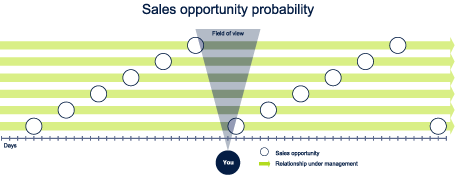 At best, most marketing communications are irrelevant to most of their recipients, most of the time.
At best, most marketing communications are irrelevant to most of their recipients, most of the time.
At worst, these communications run the risk of damaging the very relationships they are supposed to be cultivating.
The problem is, from a marketing department’s perspective; every relationship looks like a sales opportunity.
Accordingly, marketing (and sales) people tend to design communications based upon the assumption that every recipient is in the process of making a purchasing decision.
Few potential clients are sales opportunities
Unfortunately, as the diagram below illustrates, nothing could be further from the truth.

This diagram portrays a marketplace consisting of six potential customers. Each makes a buying decision every 25 days. The duration of each decision-making process is two days.
If a marketing person (‘you’ in the diagram) were to view this marketplace for a total of eight days, only two sales opportunities would come into view.
Of course, if the marketer were to notice these two sales opportunities and assume that they were representative of the market as a whole, he would be sorely mistaken.
In the real world, the odds of a marketing communication striking a potential customer within her decision-making process are nowhere near as generous as those illustrated in this diagram.
If you’re selling a service or a ‘major’ product, your customers’ buying cycle (time between sales opportunities) is likely to be three or more years. The duration of a sales opportunity may be one or two months. And the persistence of your marketing communication (how long it stays top-of-mind) may be less than a week. (In this more realistic scenario, only one out of every 144 recipients of your communication would be in the process of making a purchasing decision.)
The real cost of irrelevant communication
In other words, the odds of your communication striking any given customer at just the right time is comparable to the odds of your being able to spear a particular fish in a pond, while wearing a blindfold!
Marketers traditionally compensate for these lousy odds by broadcasting their sales communications to large numbers of potential customers simultaneously.
Now, this approach is like electrifying the pond. You’ll get your fish, but the pond will sustain a lot of collateral damage in the process!
Obviously, repeated exposure to irrelevant communications (perhaps for a period of many years) is likely to damage your relationships with potential clients. If these communications are delivered by e-mail, many recipients will eventually unsubscribe themselves from your list — cutting-off your future access to them.
You could argue that this collateral damage is likely to be minor, because those individuals for whom your communications are irrelevant are more likely to simply treat them with indifference.
This is a valid argument. However it ignores the opportunity cost of this promotional approach.
What if, instead of deliberately creating and distributing communications that will be treated with indifference by the greater majority of your marketplace, you were to create communications that were relevant to recipients, at any stage of their buying cycles?
If this were possible, each communication would make a positive contribution to a developing relationship with your potential customers.
Well it is possible.
Invest in relationships, not sales opportunities
All you have to do, is identify a basis for communication that transcends your quest for sales opportunities. Our article entitled The importance of getting religion explains that this basis for communication should consist of the intersection between your market’s interests and your expertise (and credibility).
These relationship-building communications may be less effective at inciting action from that small percentage of recipients who are in the midst of their decision-making processes — but that’s okay.
The effectiveness of your communication should not be measured on an individual-to-individual basis; it should be measured across the marketplace as a whole.
Remember, when you broadcast a communication to your marketplace, those potential customers who are ready to buy today are a tiny minority. You’ll enjoy a significantly greater return on investment if you design your communications to be relevant to those individuals who are not currently sales opportunities!